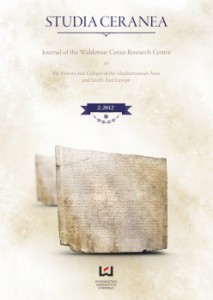Periodic Revival or Continuation of the Ancient Military Tradition? Another Look at the Question of the Katáfraktoi in the Byzantine Army
Periodic Revival or Continuation of the Ancient Military Tradition? Another Look at the Question of the Katáfraktoi in the Byzantine Army
Author(s): Michał WojnowskiSubject(s): History
Published by: Wydawnictwo Uniwersytetu Łódzkiego
Summary/Abstract: This article discusses the question of origin and identity of katáfraktoi – heavy-armoured cavalry in Byzantium. In the specialist literature on the subject, there is a widespread opinion that the heavily-armoured elitist cavalry, defined as catafracti and clibanarii had existed from the Hellenistic period until the end of Late Antiquity. Whereas a comparison of the construction, material and use of the individual elements of weapons and armour used by the Byzantine heavy cavalry from the sixth century and the first half of the seventh century with those of the ancient catafracti and clibanarii, allows us to draw the conclusion that the Byzantine heavily armed cavalry was its continuation, not necessarily in respect of the identity of the formations and their tactics, but more so in respect of the used arms and other elements of equipment. The term catafracti was not used at that time. Classifying the Byzantine cavalry from this period as catafracti, despite the fact that it is not usually defined in this way is based on the opinion of emperor Leo VI, expressed in Tactica, in accordance with which the chief element which distinguished catafracti and clibanarii units from other types of cavalry, was the complete armour of both the horse and rider. In spite of the fact, that the Romans, in response to the Sasanid heavy horsemen created their own mailed cavalry described by names catafracti or clibanarii, the influence of the Steppe people (principally the Huns and Avars) was more pronounced in the next centuries. Their weapons and tactics completely transformed the Byzantine way of war. In particular, this development concerned the cavalry – the main striking force of Byzantine army at this time. As we have seen, a disappearance of the ancient terms catafracti and clibanarii and their tactics (fighting in wedge-column order) was linked with this process of change. In the 10th century, in contemporary military treatises the term katáfraktoi appeared once again, a fact that can be connected with a usage typical for the “Macedonian renaissance”. At this time, the elitist formations of this type constituted a force marginal as compared to other cavalry units making up the Byzantine forces. However, the appearance of the 10th century katáfraktoi were a practical effect of the revival of ancient traditions in the Byzantine culture: they were not a formation which was only modeled on its ancient predecessor, but its constituted a continuation of the ancient patterns. The horsemen were equipped with similar protective armour as their ancient forerunners. They also applied the same tactics, for instance by fighting in the wedge-column order, which is ascribed to the ancient cavalry of this type. Sources mentioned above indicates, that this kind of battle array was reintroduced at this time. Moreover, the katáfraktoi were also present as a main striking cavalry force in the Comnenian army, which indicates, that heavy-armoured cavalry was still necessary.
- Issue Year: 2012
- Issue No: 2
- Page Range: 195-220
- Page Count: 26
- Language: English

